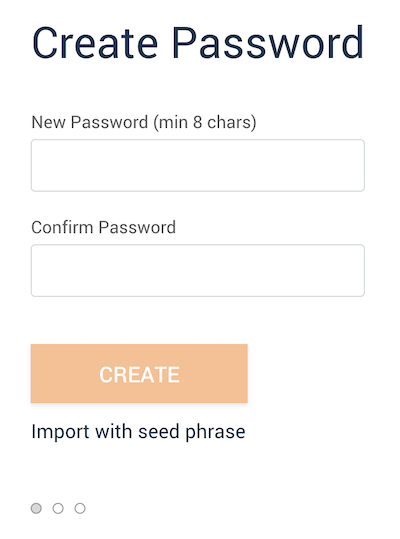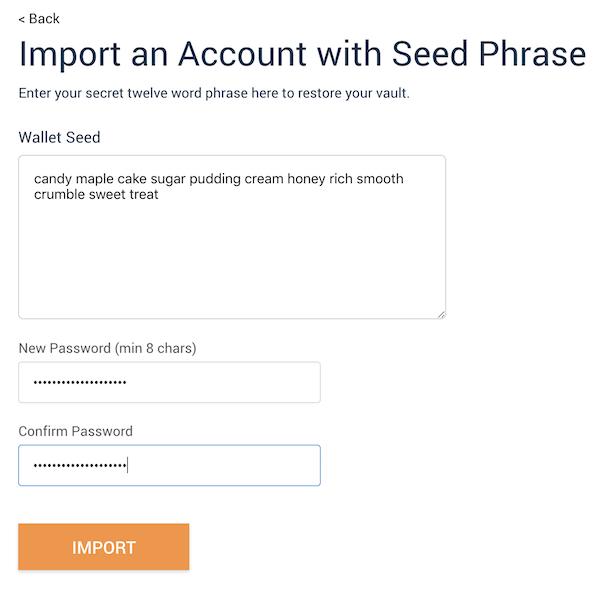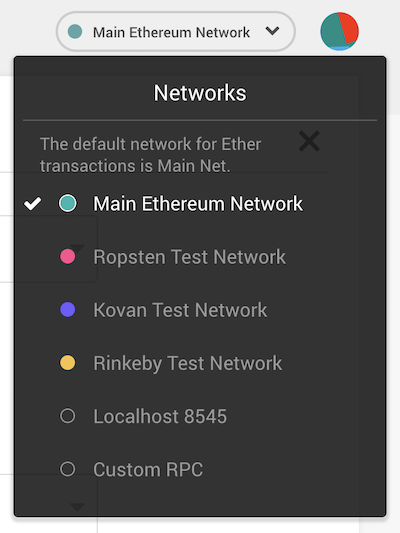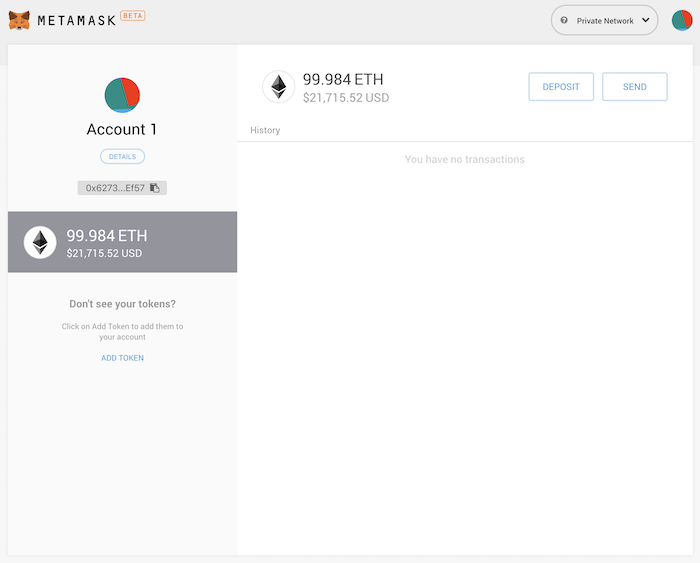Truffle and MetaMask¶
Before you can interact with smart contracts in a browser, make sure they're compiled, deployed, and that you're interacting with them via web3 in client-side JavaScript. We recommend using the @truffle/contract library, as it makes interacting with contracts easier and more robust.
Note: For more information on these topics, including using @truffle/contract, check out our Pet Shop tutorial.
Once you've done the above, you're ready to use MetaMask.
What is MetaMask?¶
MetaMask is the easiest way to interact with dapps in a browser. It is an extension for Chrome or Firefox that connects to an Ethereum network without running a full node on the browser's machine. It can connect to the main Ethereum network, any of the testnets (Ropsten, Kovan, and Rinkeby), or a local blockchain such as the one created by Ganache or Truffle Develop.

For development with Truffle this means we can use our dapp the same way users will interact with it on a live network.
Installing MetaMask¶
-
To install MetaMask for Chrome, go to the Chrome Web Store and click the Add to Chrome button.
-
To install MetaMask for FireFox, go to the Firefox Add-ons page and click the Add to Firefox button.
With our front-end ready to be used and MetaMask installed, we're ready to see our dapp in all its glory.
Using MetaMask with Ganache¶
Ganache is a graphical application that runs a blockchain that can be used for testing purposes. It runs on 127.0.0.1:7545.
Note: We recommend specifying 127.0.0.1 instead of localhost because the address does not require a network connection and so is more suitable for development.
Detecting MetaMask's web3 injection¶
Before diving in, we'll need to make sure the dapp is checking for MetaMask's web3 instance and that the extension itself is configured properly with Ganache.
MetaMask injects its own web3 instance, so we'll want to make sure we're checking for that. After the window has loaded perform the following check:
// Is there an injected web3 instance?
if (typeof web3 !== 'undefined') {
App.web3Provider = web3.currentProvider;
web3 = new Web3(web3.currentProvider);
} else {
// If no injected web3 instance is detected, fallback to Ganache.
App.web3Provider = new web3.providers.HttpProvider('http://127.0.0.1:7545');
web3 = new Web3(App.web3Provider);
}
Setting up MetaMask¶
To use Ganache with MetaMask, click the MetaMask icon in your browser and this screen will appear:

MetaMask initial screen
Click Import with seed phrase. In the box marked Wallet Seed, enter the mnemonic that was displayed when launching Ganache.
Warning: Do not use this mnemonic on the main Ethereum network (mainnet). Make sure that you set the network to "Private Network" (use the "Custom RPC" setting). See below for details.
Enter a password below that and click OK.

MetaMask seed phrase
Now we need to connect MetaMask to the blockchain created by Ganache. Click the menu that shows "Main Network" and select Custom RPC.

MetaMask network menu
In the box titled "New RPC URL" (to the right of "New Network") enter http://127.0.0.1:7545 and click Save.
The network name at the top will switch to say "Private Network". Click the cross in the top-right of the current window close out of the page and return to the Accounts page.
Now that we've connected MetaMask to Ganache, you'll be taken to the accounts screen. Each account created by Ganache is given 100 ether. The first account should have less than the others because that account supplies the gas for smart contract deployment. Since you've deployed your smart contract to the network, this account paid for it.
Click the account icon in the upper-right to create new accounts, the first 10 of which will correspond to the 10 accounts displayed when you launched Ganache.

MetaMask account
Using MetaMask with Truffle Develop¶
Truffle Develop is a command-line application that runs a temporary blockchain that is also used for testing purposes. It runs on 127.0.0.1:9545.
Note: We recommend specifying 127.0.0.1 instead of localhost because the address does not require a network connection and so is more suitable for development.
Using MetaMask with Truffle Develop is very similar to that of Ganache. The only difference is that Truffle Develop runs by default on 127.0.0.1:9545, so you'll want to edit the above web3 code to say:
// Is there is an injected web3 instance?
if (typeof web3 !== 'undefined') {
App.web3Provider = web3.currentProvider;
web3 = new Web3(web3.currentProvider);
} else {
// If no injected web3 instance is detected, fallback to Truffle Develop.
App.web3Provider = new web3.providers.HttpProvider('http://127.0.0.1:9545');
web3 = new Web3(App.web3Provider);
}
In MetaMask, when entering the "New RPC URL", enter http://127.0.0.1:9545.
Using MetaMask with Ganache CLI¶
Using MetaMask with Ganache CLI is also very similar to that of Ganache. The only difference is that Ganache CLI runs by default on http://127.0.0.1:8545 so you'll want to edit the above web3 code to say:
// Is there is an injected web3 instance?
if (typeof web3 !== 'undefined') {
App.web3Provider = web3.currentProvider;
web3 = new Web3(web3.currentProvider);
} else {
// If no injected web3 instance is detected, fallback to Ganache CLI.
App.web3Provider = new web3.providers.HttpProvider('http://127.0.0.1:8545');
web3 = new Web3(App.web3Provider);
}
In MetaMask, when entering the "New RPC URL", enter http://127.0.0.1:8545.